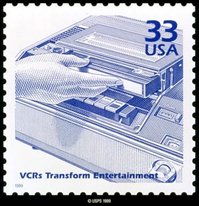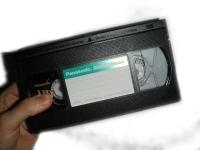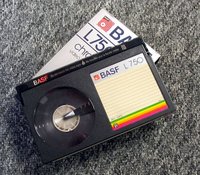Videocassette recorder

The videocassette recorder (or VCR, more commonly known in the British Isles as the video recorder), is a type of video tape recorder that uses removable cassettes containing magnetic tape to record audio and video from a television broadcast so it can be played back later. Many VCRs have their own tuner (for direct TV reception) and a programmable timer (for unattended recording of a certain channel at a particular time).
Later model VCRs can record and play tapes both in Standard Play (SP) format and in Long Play (LP) format. LP format increases the available recording time, at the loss of some video and sound quality. Some can even record/play in the Extra Long Play (EP, ELP, or SLP) format, which slows down the tape speed to about one third of SP; however, this causes even greater loss of sound and video quality. Extra long play was mainly aimed at the American market, where the general public seemed less concerned with playback quality.
History
Before the advent of the VCR proper, reel-to-reel VTRs were marketed by Sony, Ampex, RCA, Philips, and others. Most of these did not have timers, and were mainly used by schools and colleges to record educational programmes, and by businesses as a means of distributing training films. Even earlier, in the 1950s, British enthusiasts could buy home kinescope kits which allowed the filming of TV shows on 16mm film.
In 1958, Ampex took its color video tape recorder to Russia and demonstrated it before Vice President Richard Nixon and Nikita Khrushchev, Premier of the USSR. A color video recording was brought back to the US and seen on American television. RCA also had taken color television equipment and cameras to the USSR.
In the early 1970s the Dutch electronics company Philips developed a format (confusingly called "Video Cassette Recording", and also known as the N1500 format, after the first recorder's model number) that used square cassettes with a recording time of one hour. The machines were equipped with crude timers that used rotary dials. As they were expensive, the system never caught on for home use, although a later (and incompatible) long-play version ("VCR-LP"), which used the same tapes, sold quite well to schools and colleges.
It was not until the late 1970s, when European and Japanese companies developed more technically advanced machines with more accurate electronic timers and greater tape duration, that the VCR started to become a mass market consumer product. By 1980 there were three competing technical standards, with different, physically incompatible tape cassettes.
One, the Video 2000 or V2000 system, also from Philips and originally known as VCC for "Video Compact Cassette", dropped out of the running quite quickly. It worked well, and gave a good quality recording and playback, as it used piezoelectric head positioning to dynamically adjust the tape tracking. It was also notable in that its cassettes had two sides, like a record or audio compact cassette. However, V2000 hit the market after the other two rivals, and limited features and a reputation for unreliability ensured only limited sales before it was cancelled in 1985. V2000 was only available in Europe.


The two major standards were Sony's Betamax (also known as Betacord or just Beta), and JVC's VHS, which battled for sales in what has become known as the original and definitive Format War.
Betamax was first on to the market, and was technically more sophisticated, but the lower-quality VHS boasted longer recording times, and was easier to get hold of, particularly in the rental market. VHS began to pull ahead, and as more VHS recorders came into use, and more VHS films became available, network effects eventually squeezed Betamax out of the consumer market.
(A related system called Betacam still remains in use for high quality professional recording equipment, though that itself is now being replaced by digital tape formats.)
Various reasons are given for the failure of the Beta consumer format:
- Some accounts claim that VHS won because it initially allowed for twice the recording time - the original Beta format was limited to one hour, but this was soon replaced by the two-hour Beta II version. Beta I was obsolete by the time Betamax reached Europe, in 1978
- Others attribute the success of VHS to the greater availability of pornography on that medium, reflecting the long standing tradition of pornography being the driving force for the takeup of new media (the Internet being another obvious example).
- JVC and Sony used different marketing models for their technology: JVC licensed their VHS technology to consumer electronics companies like Zenith and RCA, which then produced low-cost VCRs, enriching JVC through royalties paid under its license. Fewer companies were licensed to produce Beta machines.
- The VHS camp had access to high-street TV rental chains (in the UK) like DER and MultiBroadcast. With a VCR costing about a months wages, two competing standards, and a reputation for expensive repair bills, rental was considered the more attractive option at the time.
In the early 1980s, the film companies in the USA fought to suppress the device in the consumer market, citing concerns about copyright violations. However, in Sony Corp. of America v. Universal City Studios, Inc., the Supreme Court of the United States ruled that the device was allowable for private use, thereby guarenteeing market acceptance. However in the years following, the film companies found that videorecordings of their products had become a major income source. However, television broadcasters found the widespread use of this device was threatening their advertising business model because viewers then have the ability to either fast forward through television commericals, or pause recording when they are broadcast.
In the late 1990s and early 2000s, DVD gradually overtook the VCR as the most popular format for playback of prerecorded video. DVD Video Recorders and Digital video recorders such as TiVo have recently begun to drop in price in developed countries, signaling the end is near for VCRs in those markets.
Piracy protection
Macrovision is a system that reduces the quality of recordings made from commercial video tapes, DVDs and pay-per-view broadcasts by adding random peaks of luminance to the video signal during vertical blanking. These confuse the automatic level adjustment of the recording VCR which causes the brightness of the picture to constantly change, rendering the recording unwatchable.
When creating a copy-protected videocassette, the Macrovision-distorted signal is stored on the tape itself by special recording equipment. By contrast, on DVDs there is just a marker asking the player to produce such a distortion during playback. All standard DVD players include this protection and obey the marker, though unofficially many models can be modified or adjusted to disable it.
Also, the Macrovision protection system may fail to work on older VCR's, usually due to the lack of an AGC system. VCR's dubbed for "professional" usage typically have have an adjustable AGC system or even specific "Macrovision removing" circuits and can thus copy protected tapes with or without preserving the protection. Such VCRs are usually overpriced and sold exclusively to certified professionals (video editors, TV stations etc.) via controlled distribution channels in order to prevent their being used for producing illegal copies.
New media
The S-VHS format was introduced in an attempt to breathe new life into the aging VCR technology, but it did not gain sufficient momentum in the consumer market due to its higher initial cost for both machines and video tape, by the time JVC lowered prices on S-VHS machines and video tape, the arrival of the new digital video formats spelled the end of analogue tape development.
For home video recording, both Personal Video Recorders (such as TiVo, Mythtv and ReplayTV) and DVD recorders are becoming popular, although neither has yet supplanted the VCR. In fact, Tivo cooperates well with VCRs which can be used to archive PVR recordings. However, the introduction of recordable DVDs with sufficient recording capacity on to the regular market with their advantage of random access could spell the doom of the VCR once the price comes down significantly.
The main drawback with recordable DVD is not the technology itself, but of the disc formats. At present, no less than three different types of DVD recordable disc exist. These are DVD + (plus), DVD - (dash) (both in record once and rewritable versions) and DVD-RAM (which is always rewritable). All three are backed by different consumer electronics manufacturers, and none shows any sign (as of 2004) of gaining "critical mass" in the marketplace. Consumers wary of another format war (similar to the Betamax versus VHS debacle of the early 1980s), has meant that sales of consumer DVD recorders have been comparatively sluggish, although many recorders are now able to record onto both DVD+ and DVD- media.
Another important drawback of DVD recording is that one DVD is limited to two hours of recording if the quality is not to be significantly reduced, while VHS tapes are readily available up to 210 minutes (standard play) in NTSC areas and even 300 minutes in PAL areas. The advent of the recordable two-layer DVD in late 2004, if it gets widely adopted, will reduce this disadvantage.
See also
- Telerecording
- TV/VCR combo
- Kinescope
- Write protection
- Sony Corp. v. Universal City Studios
- Dew warning
External links
- Total Rewind – the Virtual Museum of Vintage VCRs
- Fixer Corp. VCR Self-Repair Instruction Website for about 60 models
